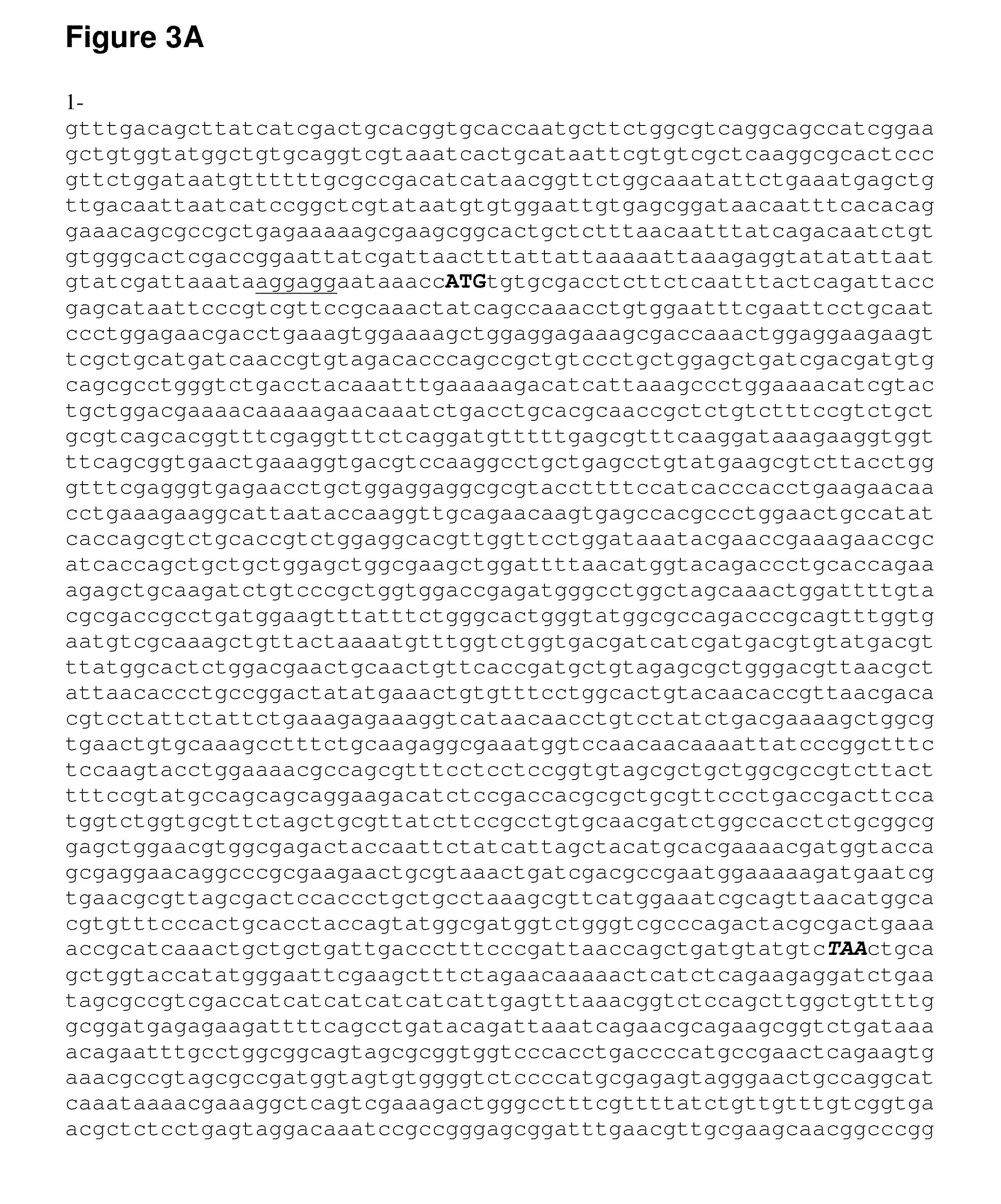Increased isoprene production using mevalonate kinase and isoprene synthase
a technology of mevalonate kinase and isoprene, which is applied in the direction of enzymology, biochemistry apparatus and processes, transferases, etc., can solve the problems of high cost, time-consuming, and unattractive yield of isoprene from naturally occurring organisms
- Summary
- Abstract
- Description
- Claims
- Application Information
AI Technical Summary
Benefits of technology
Problems solved by technology
Method used
Image
Examples
example 1
Expression Constructs and Strains
I. Construction of Plasmids Encoding Mevalonate Kinase.
[0435]A construct encoding the Methanosarcina mazei lower MVA pathway (Accession numbers NC—003901.1, NC—003901.1, NC—003901.1, and NC—003901.1, which are each hereby incorporated by reference in their entireties) was synthesized with codon optimization for expression in E. coli. This construct is named M. mazei archaeal Lower Pathway operon (FIGS. 46A-46C) and encodes M. mazei MVK, a putative decarboxylase, IPK, and IDI enzymes. The gene encoding MVK (Accession number NC—003901.1) was PCR amplified using primers MCM165 and MCM177 (Table 4) using the Strategene Herculase II Fusion kit according to the manufacturer's protocol using 30 cycles with an annealing temperature of 55° C. and extension time of 60 seconds. This amplicon was purified using a Qiagen PCR column and then digested at 37° C. in a 10 uL reaction with PmeI (in the presence of NEB buffer 4 and BSA). After one hour, NsiI and Roche b...
example 2
Production of Isoprene by E. coli Expressing the Upper Mevalonic Acid (MVA) Pathway, the Integrated Lower MVA Pathway (gi1.2KKDyI), Mevalonate Kinase from M. mazei, and Isoprene Synthase from Kudzu and Grown in Fed-Batch Culture at the 20 mL Batch Scale
Medium Recipe (Per Liter Fermentation Medium):
[0453]Each liter of fermentation medium contained K2HPO4 13.6 g, KH2PO4 13.6 g, MgSO4* 7H2O 2 g, citric acid monohydrate 2 g, ferric ammonium citrate 0.3 g, (NH4)2SO4 3.2 g, yeast extract 1 g, and 1000× Trace Metal Solution 1 ml. All of the components were added together and dissolved in diH2O. The pH was adjusted to 6.8 with ammonium hydroxide (30%) and brought to volume. Media was filter sterilized with a 0.22 micron filter. Glucose 2.5 g and antibiotics were added after sterilization and pH adjustment.
1000× Trace Metal Solution:
[0454]1000× Trace Metal Solution contained citric Acids*H2O 40 g, MnSO4*H2O 30 g, NaCl 10 g, FeSO4*7H2O 1 g, CoCl2*6H2O 1 g, ZnSO4*7H2O 1 g, CuSO4*5H2O 100 mg, H...
example 3
Production of Isoprene by E. coli Expressing the Upper Mevalonic Acid (MVA) Pathway, the Integrated Lower MVA Pathway (gi1.2KKDyI), Mevalonate Kinase from M. mazei, and Isoprene Synthase from Kudzu and Grown in Fed-Batch Culture at the 15-L Scale
Medium Recipe (Per Liter Fermentation Medium):
[0459]Each liter of fermentation medium contained K2HPO4 7.5 g, MgSO4*7H2O 2 g, citric acid monohydrate 2 g, ferric ammonium citrate 0.3 g, yeast extract 0.5 g, and 1000× Modified Trace Metal Solution 1 ml. All of the components were added together and dissolved in diH2O. This solution was autoclaved. The pH was adjusted to 7.0 with ammonium hydroxide (30%) and q.s. to volume. Glucose 10 g, thiamine*HCl 0.1 g, and antibiotics were added after sterilization and pH adjustment.
1000× Modified Trace Metal Solution:
[0460]1000× Modified Trace Metal Solution contained citric Acids*H2O 40 g, MnSO4*H2O 30 g, NaCl 10 g, Fe504*7H2O 1 g, CoCl2*6H2O 1 g, ZnSO4*7H2O 1 g, CuSO4*5H2O 100 mg, H3BO3 100 mg, and NaM...
PUM
| Property | Measurement | Unit |
|---|---|---|
| Concentration | aaaaa | aaaaa |
| Temperature | aaaaa | aaaaa |
| Volume | aaaaa | aaaaa |
Abstract
Description
Claims
Application Information
 Login to View More
Login to View More - R&D
- Intellectual Property
- Life Sciences
- Materials
- Tech Scout
- Unparalleled Data Quality
- Higher Quality Content
- 60% Fewer Hallucinations
Browse by: Latest US Patents, China's latest patents, Technical Efficacy Thesaurus, Application Domain, Technology Topic, Popular Technical Reports.
© 2025 PatSnap. All rights reserved.Legal|Privacy policy|Modern Slavery Act Transparency Statement|Sitemap|About US| Contact US: help@patsnap.com



